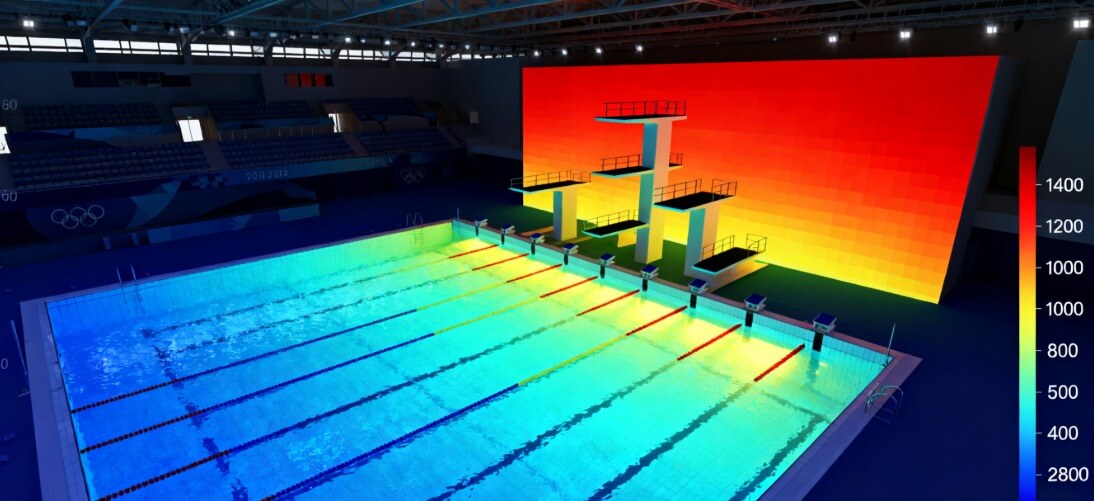パリ2024アクアティクスセンターのオリンピックグレードLEDスタジアム照明

クイックリファレンス:パリ2024アクアティクスセンターのLEDスタジアム照明仕様
以下の表は、パリ2024水泳センターの放送および競技準備に使用されたLEDスタジアム照明の仕様をまとめたものです。これらのベンチマークは、スポーツスタジアムのLED照明のベストプラクティスを求める会場設計者、エンジニア、運営者にとって役立ちます。
| パラメータ | パリ2024水泳センターのターゲット | 目的 / 備考 |
|---|---|---|
| 平均垂直照度(Ev) | 1,400~1,600ルクス(カメラに面した飛行機の場合) | OBS および高フレーム レート カメラの放送グレードの可視性を保証します。 |
| 水平照度(Eh) | 1,000~1,200ルクス(プールデッキとダイビングゾーン) | 競技エリアにおける選手の安全と観客の視界を確保します。 |
| 均一性比(U1、Ev/Eh) | ≥ 0.7 | レーン、ボード、競技場全体で均一なカバレッジを維持します。 |
| 相関色温度(CCT) | 5,600 K ± 300 K | 放送用の日光バランスに合わせ、カメラで自然な肌の色合いを保証します。 |
| 演色評価数(CRI) | 90歳以上 | アスリート、水、会場のブランディングの正確な色再現を保証します。 |
| ドライバーのパフォーマンス | ちらつきのない、2 kHzを超える高周波変調 | 放送の再生中にスローモーションのちらつきや一時的なアーティファクトが発生するのを防ぎます。 |
| グレアコントロール | 非対称光学系 + シールド | アスリートの視界を保護し、水の鏡面反射を軽減します。 |
| 持続可能性要因 | 低電力密度(< 15 W/m²)、PV統合、再利用可能なオーバーレイリグ | エネルギー効率、再利用、二酸化炭素排出量の削減をサポートします。 |
パリ2024オリンピック水泳センターは、現代のLEDスタジアム照明がオリンピック基準の性能を実現する上でどれほど進歩したかを実証しました。選手の視認性、放送品質の向上、そして持続可能な長期運用という3つの課題を満たすという課題に対し、この照明プロジェクトは、常設のスポーツ会場用照明器具とSLXが運用する仮設の放送用「オーバーレイ」装置を組み合わせました。この二重のアプローチにより、会場はオリンピック放送サービス(OBS)の要件を満たすと同時に、大会後のセンターの地域社会への貢献も支援することができました。
この規模のスポーツスタジアムでは初めて、エリート競技とレガシーユースの両方に対応するモジュール式システムとしてLED照明が導入されました。パリ2024モデルは、水泳競技や屋内スポーツ会場の新たな基準として、世界中で参照されています。
ディレクトリ:
1. 水上スポーツの照明設計原則

水上スポーツの照明は非常に複雑です。反射、高速移動、複数のカメラアングル、そして選手の視線など、すべてが一体となったバランスの取れた設計で実現される必要があります。パリ2024では、LEDスタジアム照明の設計は4つの主要な原則に基づいていました。
デュアルエリア照明:
競技用プールと飛び込み台には、垂直方向と水平方向にそれぞれ独立したルクスターゲットが設置されました。IESファイルと3Dシミュレーションレンダリングを使用した測光モデリングにより、選手とカメラの両方が放送に適した一貫した光量を確保しました。グレア抑制と視線保護:
照明器具は非対称光学系で配置され、水泳選手やダイバーの頭上のグレアを抑制しました。角度をつけたリギングとマスキング技術により、光が選手の目に入らないようにし、放送カメラの視界を遮ることも防止しました。水面の反射制御
デザイナーは、飛び込み競技やシンクロナイズドスイミング競技において重要な要素である、動いている水面からの不快な表面のぎらつきや鏡面反射を最小限に抑えるために、光の入射角を慎重にモデル化しました。複数の観客席に対応するレイヤード照明
このシステムは、選手だけでなく、会場内の観客や世界中の放送カメラにも配慮して調整されました。プリセットモードにより、オリンピック決勝、ウォームアップ、そしてコミュニティユースの間での迅速な切り替えが可能になりました。
その結果、すべての関係者にとってシームレスに機能する、均一でちらつきのない、視覚的に快適な環境が実現しました。
2. LEDスタジアム照明の仕様と放送対応のセットアップ
パリ 2024 では、ハイブリッド システムを採用しました。つまり、会場での日常的な運用には常設の LED 照明器具を使用し、さらに放送オーバーレイを追加して、大会の極めて高い基準を満たしました。
高い垂直照度
:カメラに面した表面は、プールのレーンと飛び込み台全体で1,400~1,600ルクスの均一性を達成しました。これは測光シミュレーションによって検証され、OBSの試運転時にも確認されました。一貫した色温度
照明器具は、マルチカメラ放送全体で一貫した色調を確保し、ライブカットやリプレイ中の色の変化を回避するために、約 5,000K で調整されています。フリッカーフリードライバー
高周波(5,000Hz以上)ドライバーにより、超スローモーション再生映像におけるフリッカーの発生をゼロに抑えました。滑らかな調光カーブにより、時間的なアーティファクトを発生させることなく、シーンチェンジを実現しました。照明器具の性能とリギング
高出力防水LED投光器と精密ビーム制御光学系を組み合わせました。各照明器具はIESプロファイルを用いてシミュレーションされ、ルクス目標値を確認し、リギング荷重を最適化しました。
これらの仕様を総合すると、スポーツスタジアムの LED 照明が、放送品質と持続可能性の両方の点で、従来のメタルハライド システムや HPS システムよりも優れていることがわかります。
.png)
3. 放送統合とOBSコンプライアンス
Meeting OBS (Olympic Broadcasting Services) broadcast standards was non-negotiable for the Paris 2024 Aquatics Centre. With billions of global viewers depending on crystal-clear coverage, every element of the lighting design had to exceed international benchmarks for professional sports broadcasting. The venue achieved compliance through meticulous attention to three critical factors:
Vertical lux & gradients – The LED stadium lights were calibrated to provide precise vertical illuminance across athletes, swimming lanes, and diving platforms. This ensured that 4K and HDR cameras captured balanced brightness, avoiding underexposed areas or excessive glare. Even in dynamic movements, athletes remained evenly lit, enhancing both visibility and broadcast clarity.
Uniformity ratios – Consistency was key to producing broadcast-ready visuals. Engineers designed the sports stadium LED lighting layout to achieve uniform light distribution across reflective water surfaces and elevated dive platforms. This minimized luminance variation, preventing distracting hotspots or shadowed zones and ensuring smooth, professional-quality images throughout live coverage.
Temporal stability – To meet slow-motion and high-frame-rate broadcast requirements, the system was rigorously tested for flicker across all dimming levels. Ceramiclite's advanced LED stadium lights technology delivered stable, flicker-free illumination, verified by comprehensive on-site testing with broadcast cameras.
Together, these measures allowed the Aquatics Centre's LED stadium lights to deliver flawless, broadcast-grade visuals. From athletes’ facial expressions to the crisp contrast of lane markers under water, every detail was captured with precision—bringing the excitement of Paris 2024 to billions of viewers around the world without compromise.
4. Venue Operation, Sustainability & Legacy
Unlike previous Olympic Games, Paris 2024 placed strong emphasis on long-term venue legacy and sustainability. The lighting strategy was carefully designed to balance short-term event needs with long-term community benefits:
Overlay vs. permanent system – To meet Olympic Broadcasting Services (OBS) requirements, SLX deployed a temporary rig that could handle the demanding broadcast lux levels. Once the Games concluded, this overlay was dismantled and redeployed for other international events. At the same time, the Aquatics Centre retained its permanent high-performance LED stadium lights, ensuring efficient daily operations for training, competitions, and public use.
Energy efficiency – By replacing traditional luminaires with modern LED stadium lights, the venue cut electricity consumption by more than 40%, a saving amplified by reduced HVAC cooling loads since LEDs generate less radiant heat. This not only lowered operating expenses but also reduced the building’s overall carbon footprint.
Sustainability focus – Temporary systems were designed with repurposing in mind, allowing them to be reused for future global sporting events. The permanent fixtures were built with modular components, enabling upgrades, resale, or recycling at the end of their lifecycle. This circular design philosophy set a new benchmark for responsible sports infrastructure.
Together, these decisions underscored Paris 2024's ambition to host the most sustainable Olympic Games in history—showcasing how cutting-edge LED stadium lighting can contribute to both event excellence and long-term community value.
5. Design Takeaways for Other Sports Venues
The Paris 2024 Aquatics Centre offers replicable lessons for other stadium and arena projects:
Model before installation — Use 3D photometric simulations to predict reflections, glare, and uniformity.
Design for multiple audiences — Plan layered lighting for athletes, spectators, and broadcasters.
Validate flicker-free drivers — Test temporal light stability for high-speed broadcast conditions.
Prioritize reusability — Select fixtures that can be repurposed, resold, or adapted for community use.
These strategies make LED stadium lighting not only a performance choice but also a sustainability strategy.
6. Conclusion: New Bar for LED Stadium Lights
The Paris 2024 Olympic Aquatics Centre demonstrated how LED stadium lights and advanced sports stadium LED lighting design can balance elite performance, flawless broadcast delivery, and environmental responsibility. By combining precise glare control, photometric modelling, and sustainable planning, the venue has become a blueprint for future stadiums worldwide.
For any arena or aquatic centre seeking to modernize, the Paris 2024 project shows that LED stadium lighting is the gold standard — delivering superior athlete visibility, broadcast-ready conditions, and long-term energy savings.
_thumb.jpg)